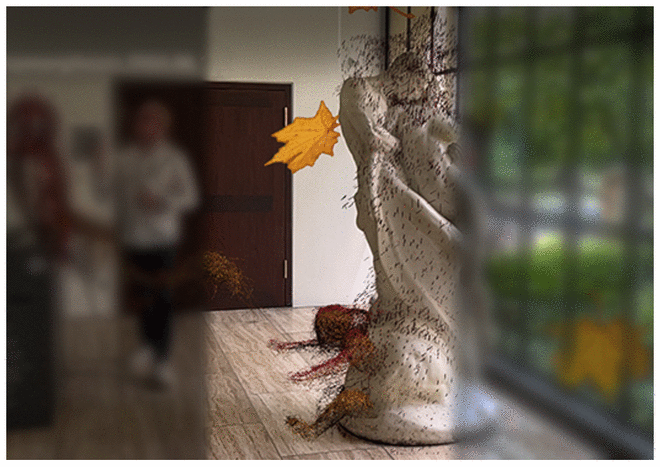FREE_IT – AR Monuments for Diversity in Weimar

Title: AR METAMORPHOSIS
Student: Edward Mulenga
Location: Main Building at Bauhaus-Universität
Description of the project:
Edward Mulenga: The project "AR - Metamorphosis" challenges conventional approaches to art creation by exploring the dynamic landscape of artistic expression through augmented reality (AR). It focuses on the intersection between augmented reality and the democratisation of art, in particular through the reinterpretation of the sculpture "The Night" by Adolf Brütt (1855-1939).
Adolf Brütt's sculpture "The Night", which was created in the late 19th century, is located in the main building of the Bauhaus University Weimar. Brütt's sculpture is positioned at the end of the left-hand corridor on the ground floor. It is located under a staircase and next to a large glass façade that floods the area with natural light.
The sculpture itself is a three-dimensional work of art that uses techniques such as carving, modelling, casting and construction [1], similar to those used today in augmented reality (AR). This comparison allows for a broader perspective: our world, both online and offline, can essentially be viewed as a sculpture.
Franz Kafka and "The Metamorphosis"
E. M.: The inspiration for the project comes from Franz Kafka's book "The Metamorphosis", in which the protagonist Gregor Samsa undergoes a profound physical and psychological transformation into a giant insect [2]. This narrative explores themes of isolation, imprisonment, hope and despair, which I believe resonate deeply with the themes embodied in Adolf Brütts sculpture "The Night".
Franz Kafka arrived in Weimar with Max Brod on 29 June 1912 and stayed at the Hotel Chemnitius [3]. Brütt and Kafka were contemporaries [4] who shared an era of creative exploration and innovation. In 1905, Brütt founded the Weimar School of Sculpture, a major institution for art education in Germany that marked a shift away from traditional academic art towards more innovative and expressive forms [5].
The three-dimensional nature of sculpture allows viewers to move around it and experience different forms and perspectives, similar to how AR can offer new dimensions to static objects. Framing the sculpture using AR enhances its intricate details and increases the viewer's engagement with the physical object. The human figures that emerge from the sculpture, rendered in vivid colour through AR, emphasise its physical presence. These figures not only symbolise a redefinition of democracy, but also draw inspiration from Kafka's novel "The Metamorphosis", in which the protagonist experiences profound helplessness and chaos after transforming into an insect.
In examining democracy, traditionally defined as a community of equals, it is suggested that this definition should be extended beyond humans to inanimate objects. This notion challenges anthropocentric views and proposes that equal freedom within a community applies not only to humans, but to all entities, animate and inanimate.
Therefore, my project explores how designers in the digital age must ensure equal freedom and inclusivity by expanding the boundaries of democracy to encompass a more universal and inclusive understanding.
AR- Interpretation
E. M.: Through AR technology, the project extends the concept of democracy beyond traditional boundaries, specifically applied to Brutt's sculpture "The Night". This approach offers a new existential perspective, that of freedom. Foucault argues that "freedom is a practice" [6] and suggests that this practice can be cultivated in certain forms through a different kind of museum. By framing the sculpture in an augmented reality where it can freely exist and interact with viewers, and by allowing users to create AR experiences, the sculpture and people can practice freedom.
Democracy is often defined as a community of equals who share a life together and is closely linked to the principles of freedom. Historically, these principles were mainly applied to humans or living objects, but excluded inanimate entities. However, in an era of anthropocentrism, the project argues in favour of extending democratic principles to all forms and challenging traditional boundaries to promote inclusivity.
In conclusion, "AR - Metamorphosis" calls for a reassessment of the scope and application of democracy and proposes that democratic ideals should transcend national boundaries and embrace all forms of existence, animate and inanimate.
[1]https://www.getty.edu/research/exhibitions_events/exhibitions/bauhaus/new_artist/history/masters_apprentices, retrieved on 07/07/2024
[2]Kafka, Franz (1917). The Metamorphosis. Leipzig: K. Wolff
[3] www.literaturland-thueringen.de/personen/franz-kafka/, retrieved on 07/07/2024
[4] husumer-stadtgeschichte.de/files/Brutt__A.__Bildhauer.pdf, retrieved on 07/07/2024
[5] Steckner, Cornelius (1989). The sculptor Adolf Brütt. Schleswig-Holstein, Berlin, Weimar. Autobiography and catalogue raisonné. Heide: Boyens
[6] Foucault, Michel (1st March 1982, Paris). Space, Knowledge, and Power, interview with Paul Rabinow translated by Christian Hubert: foucault.info/documents/foucault.spaceKnowledgePower, retrieved on 07 July 2024.
